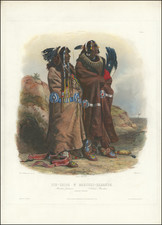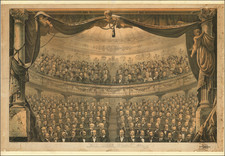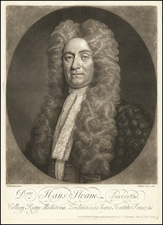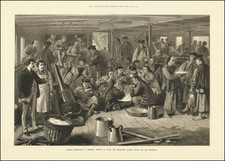Early Hand-Colored Aquatint Engravings of American Methodists and Anabaptists
A beautiful suite of four hand-colored aquatint engravings depicting American Methodists at their camp meeting and Anabaptists at a mass outdoor baptism ceremony. These nicely detailed aquatint plates reflect how certain American religious practices from the Second Great Awakening reached a level of exotica when seen through European eyes. The artist was Jacques Gérard Milbert (1766-1840). The engraving was by Matthew Dubourg, an engraver and aquatinter active in London from 1808 to 1838.
The Second Great Awakening
A major religious reform movement swept over the frontier areas of the United States in the early 19th century. This rekindled religious fervor spread through emotional preaching undertaken in crowded revivals, bringing in large numbers of new members to certain Protestant denominations. In particular, the Methodist Church, sent out circuit riding preachers to reach people living in frontier areas. Other denominations that grew during this period of religious revival include the Presbyterians and the Baptists.
The Encyclopedia Virginia describes one of these prints in some detail, suggesting the location depicted could be somewhere in Virginia:
A large group of Methodists, most of them on foot, head to a camp meeting in this hand-colored print published in 1819. These spiritual festivals were part of the so-called Second Great Awakening. Camp meetings would last for several days and were marked by intense piety and an emotional, and often physical, style of worship that featured bodily movement. - Encyclopedia Virginia (which suggests the print caption "American Methodists proceeding to their camp" depicts a scene in Virginia).
The four prints are as follows:
- Camp Meeting of the Methodists in N. America. A large group of men and women in a forest camp setting, with tents in the background. Men with arms high in the air preach from improvised pulpits made of rough-hewn boards or logs.
- American Methodists Proceeding to their Camp Meeting. A crowd of people, including a woman on a white horse, march along a country road en route to a revival camp.
- Camp Meeting of the Methodists in N. America. A large crowd of people in a camp revival. In the foreground a man falls to the ground with religion-inspired emotion. Preachers speak from a raised improvised pulpit made of rough boards [the following print in mounted on verso:]
- Anabaptist Ceremony in N. America. A large crowd attend an outdoor mass baptism. A young woman is held by a preacher as they wade into a lake, the woman looks skyward, overcome with emotion. In the foreground a young mother nurses her baby. Several people are rapt with emotion by the scene before them.
Rarity.
These prints are very rare in the market. OCLC notes single examples of only two of four, both held in the Library of Congress (Camp Meeting of the Methodists in N. America & American Methodists Proceeding to Their Camp Meeting).
Dubourg was an engraver and aquatinter who worked in London during the years 1808-1838. He often collaborated with John Heaviside Clark, signing work as "Clark & Dubourg."









![Inauguration Dance Jan. 12th '87. View in Pueblo Laguna, New Mexico [mounted albumen print, Laguna, NM, 12 January 1887]](https://storage.googleapis.com/raremaps/img/small/78741.jpg)




